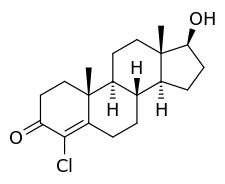 | |
 | |
| Clinical data | |
|---|---|
| Other names | Chlorotestosterone; 4-Chlorotestosterone; 4-Chloroandrost-4-en-17β-ol-3-one |
| Drug class | Androgen; Anabolic steroid |
| ATC code |
|
| Legal status | |
| Legal status |
|
| Identifiers | |
| |
| CAS Number | |
| PubChem CID | |
| DrugBank | |
| ChemSpider | |
| UNII | |
| KEGG | |
| ChEMBL | |
| CompTox Dashboard (EPA) | |
| ECHA InfoCard | 100.012.849 |
| Chemical and physical data | |
| Formula | C19H27ClO2 |
| Molar mass | 322.87 g·mol−1 |
| 3D model (JSmol) | |
| |
| |
| | |
Clostebol (INN; also known as 4-chlorotestosterone) usually as the ester clostebol acetate, is a synthetic anabolic–androgenic steroid (AAS). Clostebol is the 4-chloro derivative of the natural hormone testosterone. The chlorination prevents conversion to dihydrotestosterone (DHT) while also rendering the chemical incapable of conversion to estrogen.[citation needed] Although usually used as an ester including clostebol acetate (Macrobin, Steranabol, Alfa-Trofodermin, Megagrisevit), clostebol caproate (Macrobin-Depot), or clostebol propionate (Yonchlon), unmodified/non-esterified clostebol is also reported to be marketed, under the brand name Trofodermin-S in Mexico.[2]
Clostebol is a weak AAS with potential use as a performance enhancing drug. It is currently banned by the World Anti-Doping Agency.[3] Chlorodehydromethyltestosterone (Oral Turinabol), combining the chemical structures of clostebol and metandienone, was widely used in the East German state-sponsored doping program.[4]
- ^ Anvisa (31 March 2023). "RDC Nº 784 - Listas de Substâncias Entorpecentes, Psicotrópicas, Precursoras e Outras sob Controle Especial" [Collegiate Board Resolution No. 784 - Lists of Narcotic, Psychotropic, Precursor, and Other Substances under Special Control] (in Brazilian Portuguese). Diário Oficial da União (published 4 April 2023). Archived from the original on 3 August 2023. Retrieved 15 August 2023.
- ^ Index Nominum 2000: International Drug Directory. Taylor & Francis. January 2000. pp. 265–. ISBN 978-3-88763-075-1.
- ^ "The World Anti-Doping Code: The 2020 Prohibited List" (PDF). World Anti-Doping Agency. Retrieved 28 December 2019.
- ^ "Doping for Gold: The State-Sponsored Doping Program". PBS. 13 June 2011.